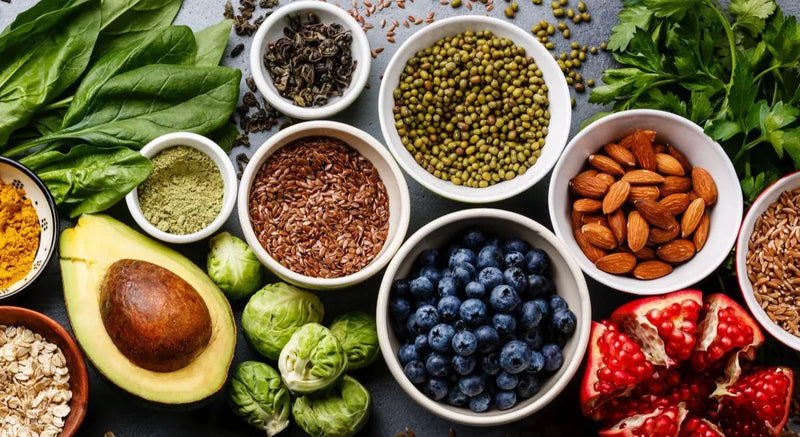Spelt, Fig and Seeded Sourdough
You’d be forgiven for thinking that Sourdough is a new craze, but in fact it is the oldest form of leavened bread, our ancestors have been eating it as part of a natural diet for centuries.
But what makes it so great besides its delicious taste and chewy crust?
Well the long fermentation process starts to break down the gluten proteins making it much easier to digest. The longer fermentation also helps reduces spikes in blood sugar often seen in modern production breads, and compared to other breads, sourdough maintains many of the original nutrients that are typically processed out of commercially produced bread.
The Starter
To make a sourdough loaf you need to have a ‘starter’ this is a living culture of wild yeast and lactic acid bacteria, cultivated by combining flour and water, it is used instead of ‘ordinary’ yeast to make the bread rise and impart a distinct sour flavour and allow for the beneficial slow fermentation process.
If you’ve never made sourdough before it can be a little tricky to start and take a little practice and patients, but it doesn’t take long to get to grips with it and it’s so worth it.
You can make your own starter, Click Here to learn how, if you’re not sure what to do or would like advice, then get in touch I’m happy to help.
Before starting to make your dough the starter must have been feed, several hours before so that it is bubbly and has doubled in size.
The Flours
I use a combination of organic spelt flour and organic stoneground white flour from Shipton Mill.
Spelt is an ancient grain, it was widely used by The Romans for its delicious flavour. It produces a highly nutritious bread rich in fibre and protein, packed with B vitamins, and a variety of minerals. It is easier on the digestive system, benefits blood sugar control and overall health.
The stoneground white crosses the divide between a traditional stoneground wholemeal and a modern white, as a result its highly nutritious, has a delicious flavour and gives a lovely open texture to the loaf. You could choose to use any strong bread flour instead of the stoneground white.
Over my years of baking bread I’ve found Shipton Mill flours far superior to supermarket bought alternatives. I love their organic, regenerative flours for their flavour and the crumb they produce, but I also love their sustainable approach to farming and the environment. Their grains are ‘sourced from growers that leave the lightest touch on the planet, working to regenerate the soil and steward the farm ecosystem’.
Lets Bake!
The timings below are what fits into my day, I go to bed early because I’m up early, but you can adjust the actual times given to fit with your day. Always ensure your sourdough starter has been 'fed' prior to beginning, that it is active and bubbly.
Ingredients
80g starter (bubbly and active)
200g spelt flour
200g stoneground white flour
280g water
1/2tsp salt
20g pumpkin seeds
20g sunflower seeds
30g dried figs chopped into small pieces
Method
7.00AM: FEED THE STARTER
25g starter
50g water
50g bread flour
This is a 1-2-2 feeding ratio. Mix water into starter until dissolved, add flour and mix. Leave to double in size, it should be very bubbly before using it to make the bread dough.
2PM: START MAKING THE DOUGH
Take 80g of active, bubbly sourdough starter and mix with the water. (Replace the rest of the starter back in the fridge for another day)
Stir well until it ‘dissolves’.
Add the flours and mix until there is no dry flour and no visible lumps. I use a stand mixer, it takes about 3 mins on a slow speed. You can do it by hand, it will take about 5-6mins. This marks the beginning of your bulk fermentation.
3PM:
Sprinkle the salt on the surface of the dough. With wet fingers push the salt into the dough, and then mix it by squeezing it through your fingers. It will separate before coming back together. Give the dough a light knead either in your stand mixer on a low speed for 2-3 mins or 4-5 mins by hand. Be careful not to over mix.
Add the chopped figs and seeds towards the end of the kneading.
Once this is done, cover the bowl, and leave on the counter for another hour.
4PM: FIRST STRETCH & FOLD
You will perform 4 sets of stretch and folds, at 45 min intervals.
This a technique used during bulk fermentation to strengthen the dough, help with the development of the gluten network, and trapping a little air into the dough.
To do the fold, grab one side of the dough and pull it up by stretching it gently and then over itself. Repeat on the other three sides. This is one set.
Fold the dough a further 3 times at 45min intervals.
The dough should begin to feel lighter and airier It will have risen (some 60-80%, it won’t double) and feel like a pillow.
If after the 4th fold the dough hasn’t risen enough wait another 45min and give a 5th stretch and fold. This can happen when ambient temperature is lower. In my Scottish kitchen I find the dough needs some extra time in the winter to develop properly, leave it somewhere warm to rest before pre-shaping.
TIP - at an ambient temperature of 20°C/68°F the bulk fermentation (which starts the moment you add in the starter, and ends with the shaping) can be as long as 7h or even 8h. If that’s the case, you can do the folds 1h apart instead of 45min, and you can also add one - two extra folds if necessary.
7PM PRE-SHAPING TIME
(Or later if you gave it some extra time)
This is the end of bulk fermentation
Remove the dough from the bowl and shape it gently into a ball
First, bring all the sides of the dough in the middle, then flip it over, pulling it towards you. Repeat until you have a relatively tight ball
Dust it with a bit of flour, cover it with the kitchen towel and let rest for 30 min
The time between pre-shaping and final shaping is also called bench rest. This gives the chance for the dough to relax, so that you don’t tear it when giving the final shape.
7.30PM FINAL SHAPE
Flour your banneton generously
There are lots of methods for shaping sourdough (have a look on YouTube). I flip the dough over, gently stretch one side and fold over the dough, gently stretch the other side over this and then roll up tightly.
Once shaped, place it in the banneton (or a bowl or even a sieve lined with a towel if you don’t have a banneton). Now place it in the fridge uncovered for the final proofing.
DAY 2
6.30AM
Or later, the dough can be in the fridge for anything between 10h - 16h
Preheat oven to 240°C ensure your dutch oven is placed in the oven during the pre-heat.
6.50 AM SCORE THE DOUGH AND PUT IT IN THE OVEN
Once oven is up to temperature remove the dough from the fridge, flip it over on to some parchment paper (which will help you transfer the dough to the dutch oven, I keep this and reuse several times) and score it, a bread lame is preferable as a knife isn’t thin enough or sharp enough.
Bake for 35 min at 240°C with the lid on. Then remove the lid and bake for another 10 min at 180°C.
Allow to cool for at least 20 mins before slicing.
Enjoy!













